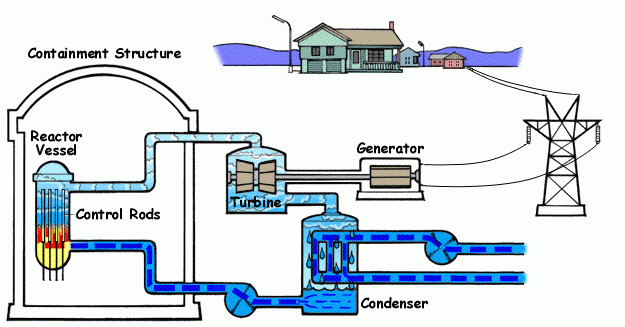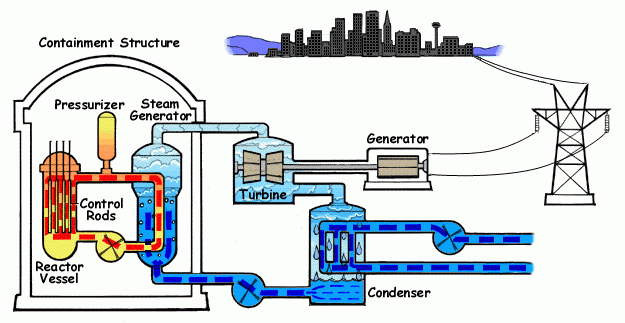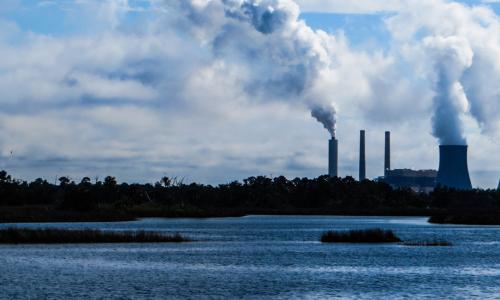Nuclear power plants generate almost one fifth of the electricity produced in the United States. The nuclear power cycle uses water in three major ways: extracting and processing uranium fuel, producing electricity, and controlling wastes and risks.
Electricity generation
Nuclear reactors generating electricity in the United States fall into two main categories: boiling water reactors (BWRs) and pressurized water reactors (PWRs). Both systems boil water to make steam (BWRs within the reactor and PWRs outside the reactor); in both cases, this steam must be cooled after it runs through a turbine to produce electricity.
Like other thermoelectric power plants, nuclear reactors use once-through or recirculating cooling systems. About 40 percent of nuclear reactors in the US use recirculating cooling systems; 46 percent, once-through cooling. [1] BWRs and PWRs use comparable amounts of water to produce a unit of electricity. Nuclear plants as a whole withdraw and consume more water per unit of electricity produced than coal plants using similar cooling technologies because nuclear plants operate at a lower temperature and lower turbine efficiency, and do not lose heat via smokestacks.[2]
| Once-through | Recirculating | Dry-cooling | ||||
| Withdrawal | Consumption | Withdrawal | Consumption | Withdrawal | Consumption | |
| Nuclear | 25,000 - 60,000 | 100 - 400 | 800 - 2,600 | 600 - 800 | N/A | N/A |
| Water withdrawn and consumed for nuclear plant cooling, in gallons of water required per megawatt-hour of electricity produced[5]. | ||||||
Dry cooling is not currently used in nuclear power generation due to safety risks of using dry-cooled technology with nuclear reactors [4] and the high costs of operating large dry-cooling fans. In addition to cooling the steam, nuclear power plants also use water in a way that no other plant does: to keep the reactor core and used fuel rods cool. To avoid potentially catastrophic failure, these systems need to be kept running at all times, even when the plant is closed for refueling.[5]
Pictured below: a boiling water reactor (top) versus a pressurized reactor (bottom).


Fuel extraction
The most common fuel for nuclear power plants is uranium. Processing uranium requires mining, milling, enrichment, and fuel fabrication, all of which use significant quantities of water.
- Mining – Uranium mining consumes one to six gallons of water per million Btus of thermal energy output, depending on the mining method.[6] Mining uranium also produces waste that can contaminate local water sources, and which can be especially dangerous given the radioactivity of some of the materials involved.
- Processing – Uranium processing consumes seven to eight gallons of water for every million Btus of thermal output.[7],[8]
- Milling – The milling process uses a mix of liquid chemicals to increase the fuel's uranium content ; milling leaves behind uranium-depleted ore that must be placed in settling ponds to evaporate the milling liquids.[9]
- Enrichment – The next step, enriching the gaseous uranium to make it more effective as a fuel accounts for about half of the water consumed in uranium processing. The conventional enrichment method in the United States is gas diffusion, which uses significantly more water than the gas centrifuge approach popular in Europe[10],[11]
- Fuel Fabrication – Fabrication involves bundling the enriched uranium into fuel rods in preparation for the nuclear reactor.
Water-related risk management
The main difference between nuclear reactor types is that pressurized water reactors keep the boiler water separate from the reactor, which allows this water to be kept free of radioactivity.[12] Nuclear cooling systems are designed so that if pipes begin to leak, local water runs into the plant rather than radioactive water leaking out. Radioactively contaminated water can then be discharged to local water sources after treatment in “liquid radwaste systems” if radioactive discharges are below federal limits.[13]
In the event of a serious accident, such as an overheated reactor, a nuclear power plant is required by federal regulation to have an emergency supply of water that can continue to cool the plant for at least 30 days. These water sources, called Ultimate Heat Sinks (UHS), are used to cool the reactor, which will continue to produce heat long after it is turned off. During an accident, a UHS may need to supply 10,000 to 30,000 gallons of water per minute for emergency cooling. A UHS can be the same water source used for power plant cooling (lake, river, or ocean) or it can be a separate, dedicated water supply.[14]
When nuclear plants draw water from natural water sources, fish and other wildlife get caught in the cooling system water intake structures. While this is an issue for all power plants with water-cooled systems, a study completed in 2005 in Southern California indicates that the problem is more acute for nuclear facilities. The study investigated impacts from 11 coastal power plants and estimated that in 2003, a single nuclear plant killed close to 3.5 million fish--32 times more than the combined impact of all of the other plants in the study.[15]
Waste storage
After being removed from the reactor, the nuclear fuel is still very hot and requires storage both to cool down and to control the risks of radiation poisoning. This stage can last as long as 15 years.[16] Water-based storage pools are a common way to cool spent uranium fuel bundles after they are used in nuclear reactors, though air-cooling can also be used. These systems consume limited amounts of water through evaporation.
For more data on lifecycle water use, see Meldrum et al. 2013.
Sources
[1] Union of Concerned Scientists. 2012. UCS EW3 Energy-Water Database V.1.3. www.ucsusa.org/ew3database.
[2] World Nuclear Association. 2013. Cooling Power Plants. London, UK.
[3] J. Macknick, R. Newmark, G. Heath, and K.C. Hallet. 2012. Operational water consumption and withdrawal factors for electricity generating technologies: a review of existing literature. Environmental Research Letters. 7 doi:10.1088/1748-9326/7/4/045802.
[4] US Government Accountability Office (GAO). 2009. Energy-Water Nexus: Improvements to Federal Water Use Data Would Increase Understanding of Trends in Power Plant Water Use. Washington, DC.
[5] UCS. 2007. Got Water? Nuclear Power Plant Cooling Needs. Cambridge, MA.
[6] UCS. 2007.
[7] A Btu or British Thermal Unit is a measure of energy content, usually used to describe the energy content of fuels. Because a Btu is so small, energy is usually measured in millions of Btus. One kilowatt hour is the rough equivalent of 3,400 Btus.
[8] UCS. 2007.
[9] J.W. Tester, and E.M. Drake. 2005. Nuclear Power. In Sustainable Energy: Choosing Among Options, 389-397. Cambridge, MA: MIT Press.
[10] J.M. Deutch, C.W. Forsberg, A.C. Kadak, M.S. Kazimi, E.J. Moniz, and J.E. Parsons. 2009. Update of the MIT 2003 Future of Nuclear Power Study.
[11] US Department of Energy (DOE). 2006. Energy Demands on Water Resources: Report to Congress on the Interdependency of Energy and Water. Washington, DC.
[12] UCS 2003. How Nuclear Power Works. Cambridge, MA.
[13] UCS. 2007.
[14] UCS. 2007.
[15] L. Gunter, P. Gunter, S. Cullen, and N. Burton. 2001. Licensed To Kill: How the nuclear power industry destroys endangered marine wildlife and ocean habitat to save money. Nuclear Information and Resource Service.
[16] Tester and Drake 2005.




